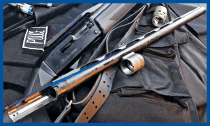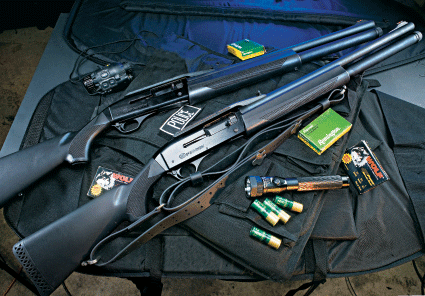Let’s make one thing clear. I like shotguns. Shotguns are the best and most versatile close quarters battle (CQB) weapons available because they can be used from CQB distances out to 50 yards and beyond with the right ammunition, and the variety of ammunition is why the fighting shotgun is such a multi-purpose tool in the police officer’s armory, and the FNH USA SLP Mark I doesn’t disappoint.
 The tactical shotgun has been in use by American police for well over a century. Throughout its history as a law enforcement (LE) and military small arm, the tactical shotgun has been called by many names. It was first termed a “riot gun” and later a “trench gun.” Later still, the LE/military shotgun came to be called a “fighting shotgun” or “combat shotgun.” While the latter terms still prevail, we prefer the term “tactical shotgun” because it precisely describes the use of the gun as a tactical small arm for military and police.
The tactical shotgun has been in use by American police for well over a century. Throughout its history as a law enforcement (LE) and military small arm, the tactical shotgun has been called by many names. It was first termed a “riot gun” and later a “trench gun.” Later still, the LE/military shotgun came to be called a “fighting shotgun” or “combat shotgun.” While the latter terms still prevail, we prefer the term “tactical shotgun” because it precisely describes the use of the gun as a tactical small arm for military and police.
For law enforcement, the shotgun remains an effective weapon despite a trend towards rifle caliber carbines. The shotgun is more flexible than rifles, offering a tremendous variety of ammunition from less lethal to high explosive. Because of this, the shotgun has seen increased military use while declining somewhat in law enforcement circles.
Advertisement — Continue Reading Below
Ammo Options
Ammunition for the tactical shotgun runs the gamut from less-lethal beanbags filled with dust to high explosive grenades and everything in between. At the low end of the lethality spectrum is rubber buckshot, beanbags and other lightweight rubber or plastic shot, which is usually the same diameter as 00 buckshot, i.e., approximately .36 caliber. There are also less-lethal baton rounds, both in wood and rubber.
At the higher end of the lethality scale are law enforcement buckshot and slugs, actually no more than reduced recoil versions of standard sporting rounds, although we should note that Remington manufactures what it calls its “Tac-8” round that’s loaded with eight rather than the usual nine pellets. This ammo typically produces a pattern that is approximately 25 percent smaller in diameter than the standard nine-pellet buckshot. Buckshot aside, most agencies use 1-ounce slugs, again reduced recoil.
In truth, at typical LE engagement distances, there is no real need for higher velocity rounds and police officers are far more likely to fire their shotguns repeatedly than sporting users. Other 12 gauge ammunition available to law enforcement includes armor piercing, breaching, dye marking and incendiary.
Advertisement — Continue Reading Below
For military use, there is even a high explosive fragmentation round that launches a fin stabilized grenade, available in both fragmentation and armor piercing varieties. We should note that the less-lethal shotgun rounds generally will not cycle semi-auto shotguns, requiring that they be manually cycled, although the majority of shotguns will be loaded with ammo that will reliably cycle the action.
Gun Details
Realizing that there was a market for a semi-auto LE shotgun, FNH USA developed and introduced its Self-Loading Police shotgun, called simply “SLP.” For those who may not be aware, FN Herstal owns both Browning and Winchester (US Repeating Arms), so most FNH USA rifles and shotguns are one version or another of firearms that carry the Winchester name, although Winchester firearms are strictly sporting, while FNH USA guns are for tactical use. All FNH USA/Winchester rifles and shotguns are manufactured in the United States.
The SLP is the tactical version of the Winchester SX3 gas-operated semi-auto shotgun. In researching this article we found extensive unsolicited user comments on hunting boards regarding the SX3, all positive and highly complimentary. The SX3 is the gun that has been proven to have extremely mild recoil, complete reliability and is the fastest operating semi-auto shotgun in the market. One video shows a shotgunning expert firing 12 rounds in 1.44 seconds. The rate of fire was so fast that it sounded as if it were coming from a machine gun. The recoil was also notably mild, given the rate of fire and the ability of the individual to control the gun. We have personally verified the FNH USA version’s fast cycling and mild recoil.
Advertisement — Continue Reading Below
Given the SX3’s commercial success, it was only a matter of time before FNH USA developed a tactical version for law enforcement. There are actually two versions of the SLP Mark I. One has a smooth bore and “Invector” interchangeable choke tubes and the other with a rifled barrel for use with slugs.
The SLP is gas operated, using what FNH USA calls their “active valve” system that is self-regulating for most standard loads up to 3-inch magnum. The piston and internal valve are integral, but operate independently, exerting less pressure on the piston for improved longevity and reliability over other systems. When light loads are fired, most of the gases are used to operate the action. With heavy loads, excess gases are vented out of the piston, so the system is self-regulating.
Another benefit of the active valve system is reduced felt recoil, a fact that has been widely noted by sporting users of the Winchester gun. According to FNH USA, the active valve system will function reliably with shotgun shells from light target loads up to 3-inch magnums. If heavy loads are used, shells with a shot charge of 1.5 ounces or more, a second gas piston is provided, but a tactical situation where such loads would be required is virtually unheard of.
Advertisement — Continue Reading Below
Stocks are matte black composite and the barrels are finished in matte powder coat. The aluminum receiver is anodized black. Like most modern shotguns, the SLP’s aluminum receiver is not a stressed component, with the bolt locking into a notch in the barrel extension that fits the receiver and held in place by the magazine sleeve and screw-on end cap. The trigger/fire control module can be removed for cleaning by simply pressing out two retaining pins and removing it. It’s that simple. The SLP has a tacky recoil pad that should help keep the stock in place under rapid-fire situations.
Unlike the commercial versions, the SLP has an extended magazine tube that accommodates eight 2-3/4-inch shells or seven 3-inch magnum shells. The tube itself is covered with a protective sleeve that mates with a notch in the fore-end. The sleeve not only protects the magazine tube, but it also serves as an interface for the fore-end that holds the barrel in place and positions the magazine tube. One note: The SLP’s literature states that the rail over the receiver is MIL-STD-1913, but the rail on both of our samples was a Weaver rail, not MIL-STD-1913. This isn’t a criticism, but simply a statement of fact of which the reader should be aware.
Although the change between smooth bore and rifled versions could be accomplished by switching barrels, FNH USA provided us with two SLPs, one with smooth bore and the other with a rifled barrel specifically for slugs. The smoothbore comes with two Invector choke tubes, one cylinder bore and one improved cylinder. The tubes screw in and out using an included T-handled wrench.
Advertisement — Continue Reading Below
The smooth bore gun’s barrel is back bored, a process that enlarges the bore diameter somewhat. On the SLP, the bore is enlarged to 0.742 of an inch. Back boring helps reduce the length of the shot string and increases velocity. The latter is due to the change in the bore’s interior volume, which changes the expansion ratio of the powder being burned.
Another benefit is that back bored barrels take less choke constriction to get the same pattern as with a standard bore, thus putting more shot in the center mass of the shot string. This feature is usually found only in custom guns. The SLP’s 5-degree forcing cone taper ensures a smooth transition from the chamber to the barrel and minimizes shot deformation.
Range Time
We found FNH USA’s SLP Mark I to live up to the expectations from the favorable reviews of the sporting version. The two triggers of both guns broke crisply at 6 pounds, which is better than some rifles we have evaluated. Both guns functioned with total reliability using reduced recoil LE ammunition. Feeding and ejection were positive and there wasn’t a single malfunction.
Advertisement — Continue Reading Below
We were especially impressed with the accuracy of the rifled barreled “slug” gun. At typical law enforcement engagement distances of approximately 20 yards, the slug gun put all three test Remington and Winchester 1-ounce slugs into essentially the same hole. Frankly, we like the accuracy and impact of slugs.
At a velocity of about 1200 feet per second (fps), the big slug delivers a tremendous kinetic energy impact and typically penetrates over 15 inches in bare 10 percent ordnance gelatin, plus the slug will reliably penetrate car sheet metal. Even if the “bad guy” is wearing Level II or IIIA body armor, there is a good chance that the kinetic impact of a center mass hit will cause his heart to go into cardiac arrest. Moreover, the slug typically shoots point of aim out to 50 yards, whereas buckshot has an effective range of only 25 yards. For those reasons our duty shotgun has rifle sights and is loaded with LE slugs.
Final Notes
Our testing of FNH USA’s SLP Mark I revealed it to be an excellent choice for any LE agency seeking a semi-auto 12 gauge shotgun. If we had to pick one, we’d go for the rifled barreled SLP and load it with LE rifled slugs. The gun delivered excellent accuracy with all ammo tested and, as mentioned, was totally reliable. The SLP has it all — reliability, low felt recoil, light weight and accuracy. It doesn’t get much better.
Advertisement — Continue Reading Below























